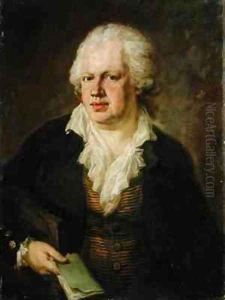Joseph Georg Edlinger Paintings
Joseph Georg Edlinger, born in 1741 in Graz, Austria, emerged as a significant figure in the world of 18th-century European art, particularly noted for his contributions to portrait painting. His life spanned a period of considerable change in Europe, witnessing the Enlightenment, the French Revolution, and the early stages of the Industrial Revolution. Despite the tumultuous times, Edlinger managed to carve out a successful career as a portraitist, capturing the likenesses of the bourgeoisie, nobility, and prominent figures of his era.
Edlinger's early life and education in art are not extensively documented, but it is known that he was active in Munich, Germany, for a significant portion of his career. Munich, being a cultural hub in the 18th century, provided a fertile ground for his artistic development. He was particularly influenced by the prevailing Rococo style, which was characterized by lightness, elegance, and an emphasis on curvaceous forms. However, Edlinger managed to infuse his work with a sense of realism and psychological depth that was ahead of his time, setting him apart from many of his contemporaries.
Throughout his career, Edlinger received commissions from various strata of society, including the clergy, nobility, and middle-class patrons, which was indicative of his versatility and adaptability to different subject matters and patron demands. His portraits are known for their detailed execution, nuanced depiction of character, and the ability to capture the essence of the sitter. This was a period when portrait painting was not only a means of documentation but also a way to communicate status, wealth, and power, and Edlinger's works stood out for their ability to convey these elements subtly and effectively.
Notably, Edlinger's contributions were not limited to portrait painting. He also engaged in creating religious and historical paintings, although these works have not received as much attention as his portraits. His religious works, in particular, reflect the influence of the Catholic Church in Bavaria and Austria, showcasing his ability to adapt his skills to different genres and themes.
Joseph Georg Edlinger died in 1819, leaving behind a legacy that has been appreciated more in retrospect. His works, which once graced the homes of the European elite, now find their place in museums and galleries, offering insights into the cultural and social fabric of the 18th century. Edlinger's ability to capture the spirit of his time, while also incorporating his unique artistic voice, makes him a noteworthy figure in the annals of European art history.
